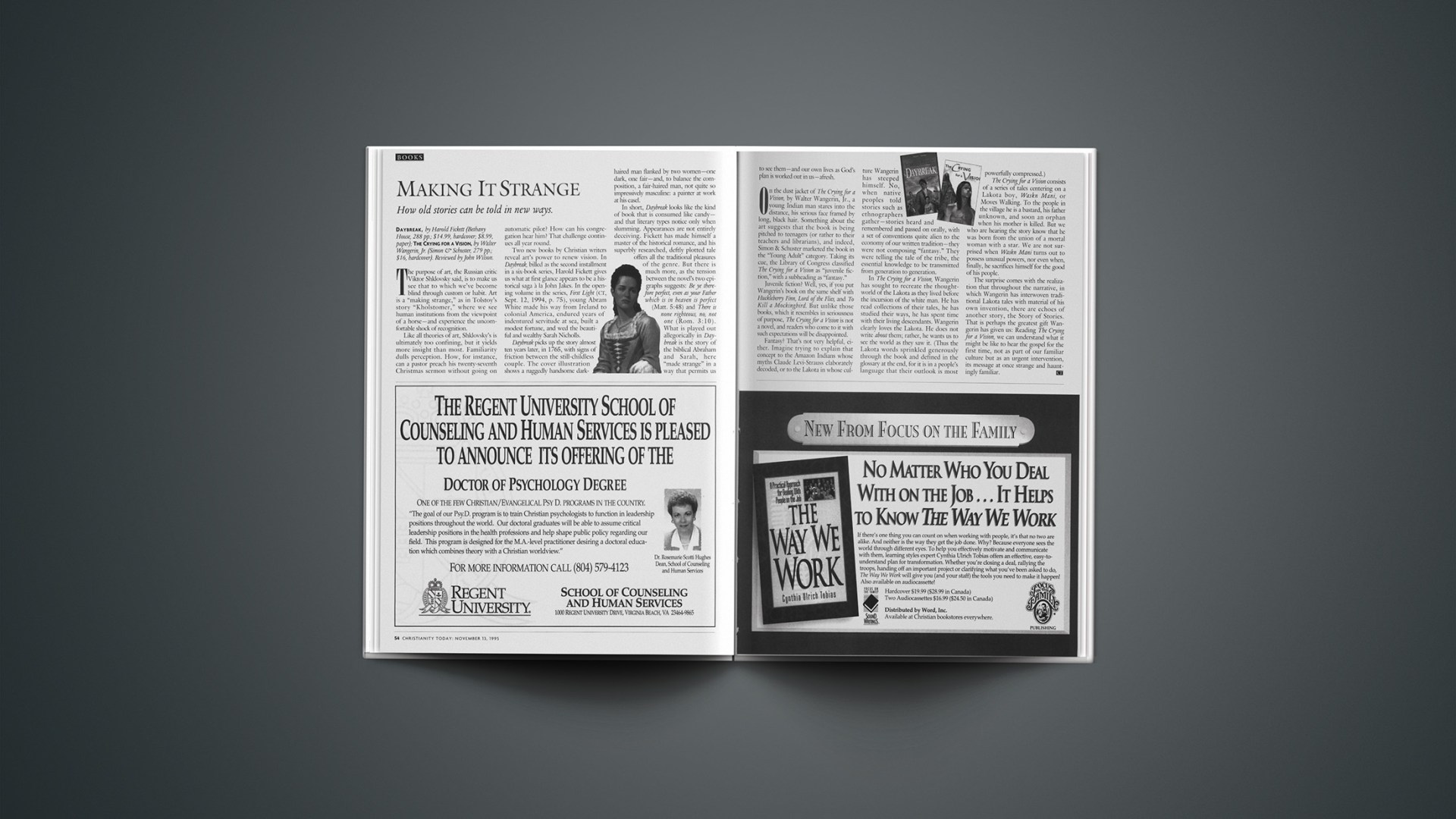Daybreak, by Harold Fickett (Bethany House, 288 pp.; $14.99, hardcover; $8.99, paper); The Crying for a Vision, by Walter Wangerin, Jr. (Simon & Schuster, 279 pp.; $16, hardcover).
The purpose of art, the Russian critic Viktor Shklovsky said, is to make us see that to which we’ve become blind through custom or habit. Art is a “making strange,” as in Tolstoy’s story “Kholstomer,” where we see human institutions from the viewpoint of a horse—and experience the uncomfortable shock of recognition.
Like all theories of art, Shklovsky’s is ultimately too confining, but it yields more insight than most. Familiarity dulls perception. How, for instance, can a pastor preach his twenty-seventh Christmas sermon without going on automatic pilot? How can his congregation hear him? That challenge continues all year round.
Two new books by Christian writers reveal art’s power to renew vision. In “Daybreak,” billed as the second installment in a six-book series, Harold Fickett gives us what at first glance appears to be a historical saga a la John Jakes. In the opening volume in the series, “First Light” (CT, Sept. 12, 1994, p. 75), young Abram White made his way from Ireland to colonial America, endured years of indentured servitude at sea, built a modest fortune, and wed the beautiful and wealthy Sarah Nicholls.
“Daybreak” picks up the story almost ten years later, in 1765, with signs of friction between the still-childless couple. The cover illustration shows a ruggedly handsome dark-haired man flanked by two women—one dark, one fair—and, to balance the composition, a fair-haired man, not quite so impressively masculine: a painter at work at his easel.
In short, “Daybreak” looks like the kind of book that is consumed like candy—and that literary types notice only when slumming. Appearances are not entirely deceiving. Fickett has made himself a master of the historical romance, and his superbly researched, deftly plotted tale offers all the traditional pleasures of the genre. But there is much more, as the tension between the novel’s two epigraphs suggests: Be ye therefore perfect, even as your Father which is in heaven is perfect (Matt. 5:48) and There is none righteous, no, not one (Rom. 3:10). What is played out allegorically in Daybreak is the story of the biblical Abraham and Sarah, here “made strange” in a way that permits us to see them-and our own lives as God’s plan is worked out in us—afresh.
On the dust jacket of “The Crying for a Vision,” by Walter Wangerin, Jr., a young Indian man stares into the distance, his serious face framed by long, black hair. Something about the art suggests that the book is being pitched to teenagers (or rather to their teachers and librarians), and indeed, Simon & Schuster marketed the book in the “Young Adult” category. Taking its cue, the Library of Congress classified “The Crying for a Vision” as “juvenile fiction,” with a subheading as “fantasy.”
Juvenile fiction? Well, yes, if you put Wangerin’s book on the same shelf with “Huckleberry Finn,” “Lord of the Flies,” and “To Kill a Mockingbird.” But unlike those books, which it resembles in seriousness of purpose, “The Crying for a Vision” is not a novel, and readers who come to it with such expectations will be disappointed.
Fantasy? That’s not very helpful, either. Imagine trying to explain that concept to the Amazon Indians whose myths Claude Levi-Strauss elaborately decoded, or to the Lakota in whose culture Wangerin has steeped himself. No, when native peoples told stories such as ethnographers gather—stories heard and remembered and passed on orally, with a set of conventions quite alien to the economy of our written tradition—they were not composing “fantasy.” They were telling the tale of the tribe, the essential knowledge to be transmitted from generation to generation.
In “The Crying for a Vision,” Wangerin has sought to recreate the thought-world of the Lakota as they lived before the incursion of the white man. He has read collections of their tales, he has studied their ways, he has spent time with their living descendants. Wangerin clearly loves the Lakota. He does not write about them; rather, he wants us to see the world as they saw it. (Thus the Lakota words sprinkled generously through the book and defined in the glossary at the end, for it is in a people’s language that their outlook is most powerfully compressed.)
“The Crying for a Vision” consists of a series of tales centering on a Lakota boy, Waskn Mani, or Moves Walking. To the people in the village he is a bastard, his father unknown, and soon an orphan when his mother is killed. But we who are hearing the story know that he was born from the union of a mortal woman with a star. We are not surprised when Waskn Mani turns out to possess unusual powers, nor even when, finally, he sacrifices himself for the good of his people.
The surprise comes with the realization that throughout the narrative, in which Wangerin has interwoven traditional Lakota tales with material of his own invention, there are echoes of another story, the Story of Stories. That is perhaps the greatest gift Wangerin has given us: Reading “The Crying for a Vision,” we can understand what it might be like to hear the gospel for the first time, not as part of our familiar culture but as an urgent intervention, its message at once strange and hauntingly familiar.
Copyright © 1995 Christianity Today. Click for reprint information.










